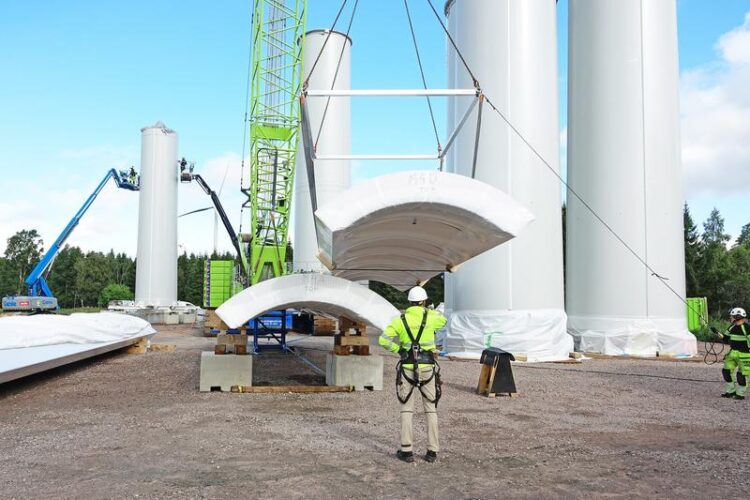For the company Modvion AB in Gothenburg, researchers from the Fraunhofer WKI accompanied the bonding of the first wooden tower for commercial wind turbines on the construction site and advised the company on complex bonding processes. The so-called “Wind of Change Tower” of the energy provider Varberg Energi AB was inaugurated on 4 March 2024.
Including a V90-2.0MW turbine from Vestas Group, the tower reaches a total height of 150 metres (pure tower height 105 metres), making it the tallest wooden wind turbine tower in the world. It consists of prefabricated modules that are glued together on site. Compared to conventional wind turbines made of concrete or steel, the timber construction method enables CO2 savings of up to 90 per cent.
The timber tower is not only more sustainable, but also offers further advantages, for example in the area of lightweight construction: in relation to its own weight, timber has a higher specific strength than steel, which means that lighter constructions are possible. This saves transport energy. In addition, tall steel towers need to be reinforced, which is not the case with wooden towers.
In terms of maintenance, the advantages are that steel towers require regular maintenance of numerous screws and bolts, which is not necessary with a glued timber construction.
Another major advantage lies in the logistics. The large-format components have to be transported to their destination. The higher the towers become, the greater the challenge of transporting them. Bridges and subways become obstacles and need to be considered. The Swedish company Modvion AB has therefore developed a patented solution: It produces prefabricated modules that can be transported by conventional lorries and assembled into a tower on site using a small crane. The individual modules consist of laminated veneer lumber (LVL) panels glued together.
The modular design also has the advantage that the height of the wooden tower is not limited. This means that heights with more intensive air currents can be reached and additional locations can be utilised for wind energy generation.
The prefabricated modules are quarter shells up to 14 metres long. Four tapered quarter shells are glued together on site. In a second step, the individual sections are placed on top of each other and connected with steel sheets.
“For the realisation of the Modvion AB concept, the bonding of the modules on the construction site is indispensable and requires a high degree of expertise, preparation and self-monitoring. Employees of the Fraunhofer WKI supported Modvion AB in technical bonding issues. We also inspected the bonding on the construction site,” explains Malte Mérono from the Fraunhofer WKI.
After the utilisation phase, which Modvion AB estimates at 25 to 30 years, the towers can be dismantled and the components separated for further applications. For example, the tower wall can be used as a heavy-duty support for the construction industry.
“We would like to continue our collaboration with Modvion AB and, among other things, support them in building a new tower by 2025. Modvion AB’s concept has great potential for the energy transition in Germany,” says Mérono.
The Fraunhofer WKI will present the results of this collaboration together with Modvion AB at the International Timber Construction Forum in Innsbruck from 4 to 6 December 2024.
Last modified:
























